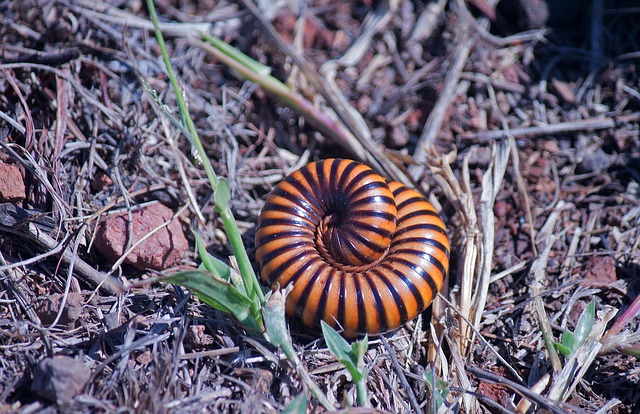Centipedes, attracted to moist darkness and water sources, often inhabit basements and crawl spaces. To combat these pests humanely, homeowners can employ eco-friendly centipede solutions like sealing entry points, controlling humidity, using natural repellents (e.g., mint oil), and introducing beneficial insects (e.g., spiders). Alternative methods include planting aromatic herbs (citronella, lavender) and applying non-toxic insecticides derived from essential oils. These strategies promote safer, sustainable living environments while preserving ecological balance.
Get rid of centipedes effectively with our comprehensive guide. Centipedes, known for their lengthy legs and aggressive behavior, can be a nuisance. Understanding their habits is key to prevention. This article explores eco-friendly strategies, non-toxic chemical treatments, and natural remedies for complete centipede elimination. Discover the best approach for your home or garden using these proven eco-friendly centipede solutions.
Understanding Centipede Behaviors and Habits
Centipedes are nocturnal creatures that prefer moist, dark spaces, making them common in basements, crawl spaces, and other areas with high humidity. Understanding their behaviors is crucial when it comes to effective control. These insects feed on small insects and arachnids, playing a role in maintaining ecosystem balance, but their presence indoors can be problematic. Centipedes are attracted to water sources and often enter homes through pipes, cracks, or gaps around utilities. They move slowly and leave distinct tracks, which can help identify their presence. Knowing their habits allows for targeted eco-friendly centipede solutions, such as sealing entry points, maintaining proper humidity levels, and using natural repellents like mint oil or diatomaceous earth.
By addressing these behaviors, homeowners can effectively eliminate centipede infestations while minimizing the use of chemical treatments, promoting safer and more sustainable living environments. Eco-friendly centipede solutions not only reduce exposure to potentially harmful chemicals but also preserve beneficial insects that contribute to a balanced ecosystem.
Eco-Friendly Prevention Strategies
Centipedes, though often overlooked, can be a significant pest issue in homes and gardens. Fortunately, there are several eco-friendly centipede solution strategies that offer effective prevention without resorting to harmful chemicals. One key approach is maintaining a clean environment by regularly cleaning and sealing entry points such as cracks and gaps in walls, windows, and doors. Removing potential hiding spots like clutter and woodpiles can also deter centipedes from taking up residence near your living spaces.
Additionally, introducing natural predators like spiders and certain species of insects can help keep centipede populations in check. Planting aromatic herbs like citronella, lavender, and mint around the perimeter of your property can serve as a natural barrier, as these plants have been shown to repel centipedes. Using organic, non-toxic insecticides derived from essential oils is another eco-friendly centipede solution that targets these pests effectively while minimizing harm to beneficial insects and the environment.
Non-Toxic Chemical Treatments
Non-toxic chemical treatments offer a popular yet nuanced approach to centipede control, catering to those seeking eco-friendly centipede solutions. These methods leverage specific chemicals that target centipedes while minimizing harm to humans, pets, and the environment. Active ingredients like boric acid or pyrethrins are commonly used; boric acid, in particular, acts as a dust or liquid, disrupting the centipedes’ outer shell and ultimately leading to dehydration and death. Pyrethrins, derived from natural plants, are highly effective insecticides that quickly knock down centipede populations but require careful application to avoid non-target organism exposure.
Unlike toxic alternatives, eco-friendly centipede solutions focus on safety and sustainability. They’re ideal for homes with children or pets and areas where environmental preservation is a priority. Professional applicators skilled in these methods ensure precise, targeted treatments that are both effective and safe, providing lasting relief from centipede infestations without compromising ecological balance.
Natural Remedies for Centipede Elimination
When it comes to dealing with centipede infestations, many homeowners seek eco-friendly centipede solutions. Natural remedies offer a gentle yet effective approach to rid your space of these pesky creatures. One popular method involves using essential oils like citronella, peppermint, and lavender, which have proven repellant properties against centipedes. Dilute these oils with water and spray the solution along baseboards, behind furniture, and in other hidden corners where centipedes tend to lurk.
Another organic option is to deploy natural predators such as spiders and ants. By promoting a balanced ecosystem within your home or garden, you can naturally control centipede populations. Certain plants like chrysanthemums, daisies, and lavender not only add beauty but also act as natural centipede repellents. Incorporating these eco-friendly centipede solutions into your pest management strategy is beneficial for both your living space and the environment.
In conclusion, eliminating centipede infestations requires a multi-faceted approach. Understanding their behaviors and implementing eco-friendly prevention strategies are key initial steps. For persistent issues, non-toxic chemical treatments offer effective control without harmful chemicals. Additionally, natural remedies provide a safe, sustainable option for those seeking eco-friendly centipede solutions. By combining these methods, homeowners can effectively manage and eradicate centipedes while minimizing environmental impact.
